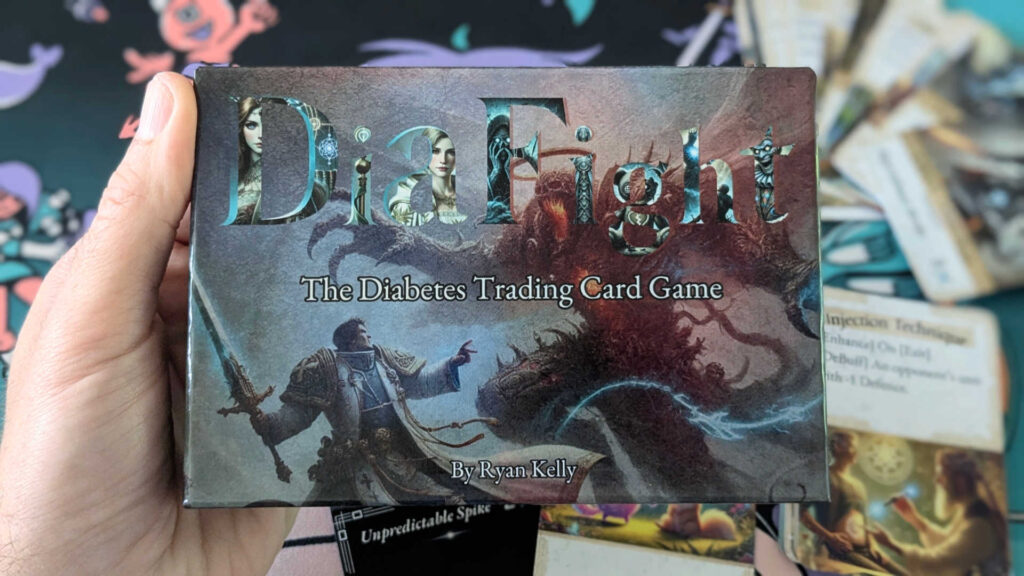It’s estimated that around 11% of the world’s adult population has diabetes; to put it another way, thats 1 in every 9 adults on the planet. However, it’s also thought that around 4 in 10 adults are actually unaware that they have the condition, which seems to be a shockingly high statistic. This would seem to suggest that there’s a lack of awareness around diabetes, which, in its simplest terms, is a chronic condition that affects either the pancreas being able to produce insulin, or when the diabetic person’s body isn’t able to effectively use insulin. That lack of awareness, perhaps even understanding, is where card game DiaFight comes in.
Table of Contents
ToggleWhat is DiaFight?
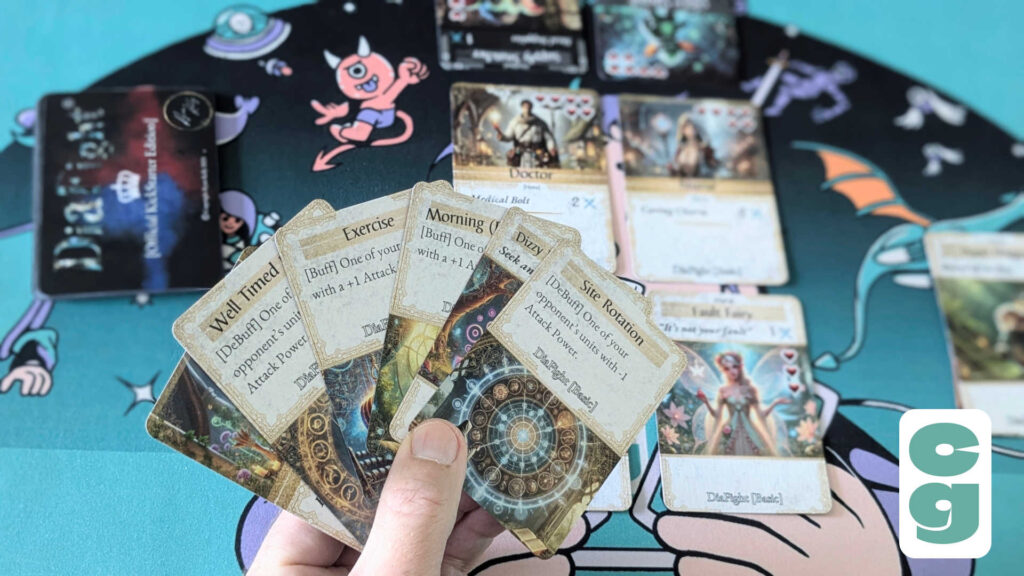
Designed and produced by solo, independent developer Ryan Kelly (also responsible for another ambitious, self-designed and produced card game, Empires Out of Time), DiaFight aims to boost understanding and confidence in dealing with diabetes for people diagnosed with the condition. Regardless of whether or not they’re newly diagnosed or have been dealing with diabetes for some time, DiaFight is designed to be an accessible way for diabetics of all ages to learn about and cope with their condition, in a way that entertains as well as informs.
How to Play DiaFight
There are two ways to play DiaFight: Basic and Advanced. Though it’s recommended to play the Basic game first, if you’re a seasoned card gamer, the Advanced game really isn’t difficult to pick up almost immediately. That said, it’s important to realize that the key to DiaFight is its accessibility, and it isn’t aimed solely at people who will already have experience with games beyond mainstream, widely known titles.
Basic DiaFight
Using the Basic rules and cards of DiaFight, players will have a deck of 20 cards (the two player set of DiaFight, which I’ve been able to test, features opposing decks: the Healthcare Team vs Diabetes Monsters), along with health and defence tracker cards (plus a handy turn phase reference too). Each player begins with 7 cards in their hand, and each turn will play up to 2 cards from their hand, attack with the units they have in play, then draw 2 cards from their deck to end their turn.
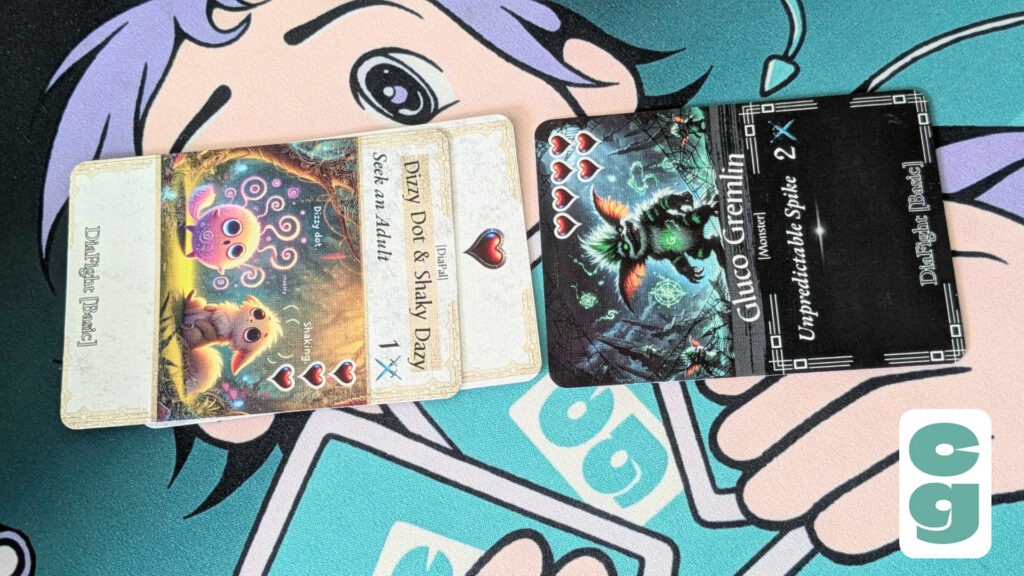
Each player may have up to 2 main units in play, and up to 2 secondary units in play too. Each unit may attack an enemy’s unit once per turn, dealing their attack power (shown with the crossed swords symbol on a unit card) to the chosen enemy unit’s health. In the example above, the Dizzy Dot & Shaky Dazy card is being attacked by Gluco Gremlin, which deals 2 damage thanks to its attack value of 2. As the Dizzy Dot & Shaky Dazy card is already on just 1 health, as you can see from Tracker card (Tracker cards are used to track a unit’s remaining health points), it’ll be down to 0 or less health after the attack. This will defeat the unit, which is then placed in its owner’s discard pile.
Buff and debuff cards can be played add or subtract to a unit’s health and attack power, with the minimum and maximum values being capped at -2 and +2; the ‘think two’ rule is applied to many concepts and mechanics in DiaFight, which helps players to easily learn and retain the basics of the game. You can see an example of a Buff card and its tracked bonus, when applied to the Fault Fairy unit, in the image below.
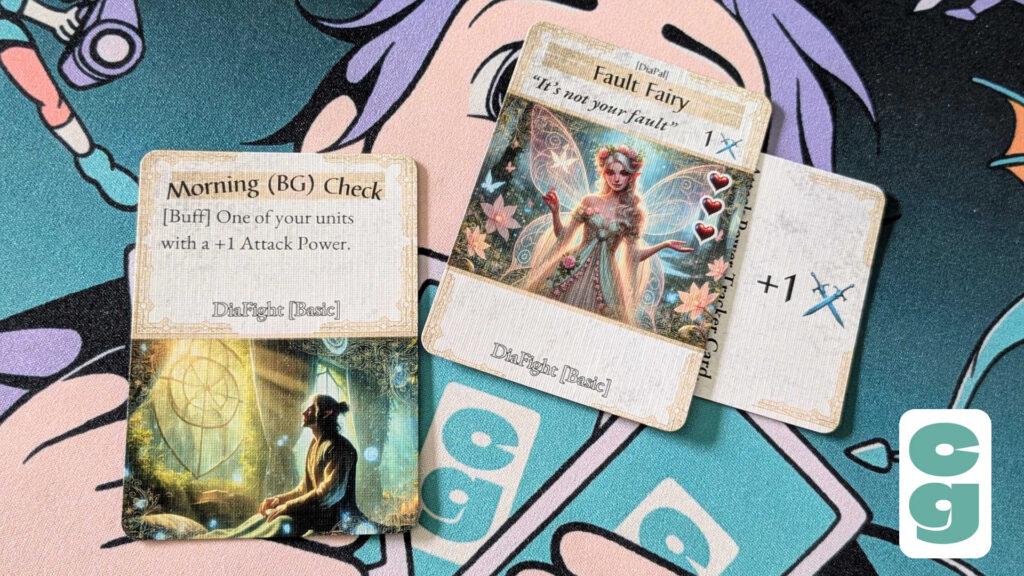
Once a player defeats all of their opponent’s units, they win the game; there’s an alternate win condition too, in that players can secure victory if their opponent doesn’t have any units on the table for two consecutive turns (there’s the ‘think two’ concept again!).
Advanced DiaFight
Once you know the Basic DiaFight game, you can then move on to using the Advanced decks. More confident gamers can feel free to start here; it plays in the same way as Basic DiaFight, with Infection trackers (or Time in Range for the Monsters deck, which does the same thing, in gameplay terms, as Infection) and units which can also have their own buffs/debuffs, along with effects on cards which can trigger upon play, when attacking or when exiting (so when being discarded from) the play area. Examples of Advanced DiaFight cards can be seen in the below image.
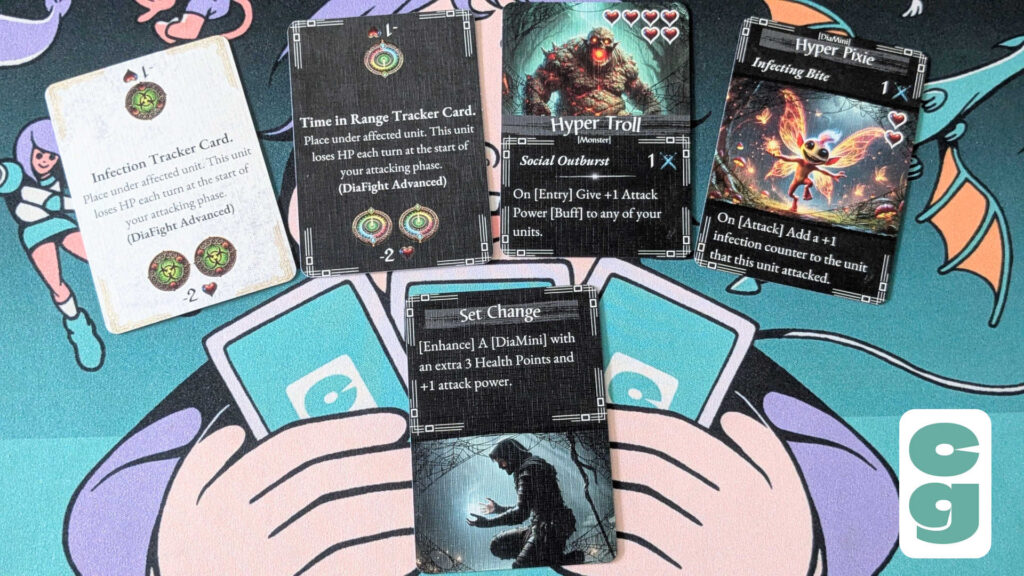
It’s also worth noting that players can build their own decks, and booster packs of cards are available; you can find deck building rules, along with general rules and tutorial videos for each variant of DiaFight, on the game’s official rules page.
How Does DiaFight Teach Players About Diabetes?
Both the Healthcare and Monsters decks feature characters, attacks and buffs/debuffs that are named after aspects of the condition or situations that diabetics will be dealing with, such as glucose monitoring and insulin management. Through the cards themselves, as well as aspects such as Infection and other conditions that occur in the Advanced game, DiaFight seeks to promote awareness, conversation and a deeper understanding of living with and managing diabetes.

It’s an admirable aim, and what’s more, it’s wrapped up in a nicely designed set of mechanics which feel really accessible, even for the most inexperienced players. The gentle rise in complexity when moving to the Advanced rules and decks isn’t off-putting at all, especially for players who already have familiarity with trading card games, or at least card games with slightly more involved mechanics than games such as, for example, Uno.
Where Can I Buy DiaFight?
Given that it’s a small press, independently produced title, you can only currently purchase DiaFight through the official online store. It’s also possible to purchase a Clinic License and pack on the store, which is designed for healthcare professionals and settings to support and engage with patients using DiaFight.
Check out our coverage of other indie games, such as Classified Information and River Rats


